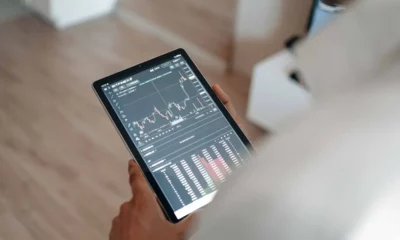Sponsored
Predicting bitcoin price trends: A look at technical indicators
Researchers use machine learning and technical indicators to predict Bitcoin price trends, analyzing past market patterns and using algorithms to forecast future movements, with the goal of improving accuracy in predictions.

Just a heads up, if you buy something through our links, we may get a small share of the sale. It’s one of the ways we keep the lights on here. Click here for more.
Predicting Bitcoin price trends can feel like guessing the future. One fact about this topic is that researchers use machine learning and technical indicators to forecast prices.
This article will guide you through understanding how these methods work to predict Bitcoin’s next moves.
Keep reading for insights on turning predictions into your advantage.
Key Takeaways
- Technical indicators like the Simple Moving Average (SMA) and Exponential Moving Average (EMA) help predict Bitcoin price trends by analyzing past market patterns.
- Machine learning uses historical data and algorithms to forecast Bitcoin prices, seeking new methods for improved accuracy in predictions.
- Decision trees use trading volume and price changes to model decisions on likely price trends, while ensemble learning combines multiple models for better forecasts.
- Evaluating performance involves assessing various machine learning algorithms’ ability to accurately predict Bitcoin prices using technical indicators.
- Continuous research into different models and techniques aims at refining the prediction of cryptocurrency movements.
Related Literature on Bitcoin Price Prediction

Several studies have explored using technical indicators and machine learning algorithms to predict Bitcoin price trends. This research focuses on understanding cryptocurrency market behavior through economic factors, trading indicators, and sentiment analysis.
Use of Technical Indicators
Technical indicators play a crucial role in predicting Bitcoin price trends. Researchers use tools like Simple Moving Average (SMA) and Exponential Moving Average (EMA) to analyze market patterns.
These indicators help in understanding past price movements and trading volume, providing insights into future trends.
“Technical analysis is key to forecasting Bitcoin’s next move.”
Experts also examine high-dimensional technical indicators for better accuracy. This method involves studying historical data closely to forecast daily returns on Bitcoin.
By focusing on the details of past performance, analysts can make educated guesses about where prices might head next.
Role of Machine Learning
Machine learning plays a crucial role in predicting Bitcoin prices.
Machine learning frameworks analyze technical indicators like Simple Moving Average (SMA) and Exponential Moving Average (EMA) to forecast Bitcoin prices.
These algorithms are used to create prediction models with high accuracy, aiming to predict the price of Bitcoin on the next day based on historical data.
Various machine learning models, such as SVM algorithms, binomial logistic regression classifiers, and random forests, have been explored for their effectiveness in predicting cryptocurrency returns.
Ongoing research continuously seeks new ways to utilize machine learning to predict changes in Bitcoin price trends.
Proposed Methodology for Predicting Bitcoin Price Trends

The proposed methodology for predicting bitcoin price trends involves using decision trees and implementing ensemble learning for performance evaluation.
Use of Decision Trees
Decision trees are utilized to predict Bitcoin prices by analyzing historical data and identifying patterns. This method involves creating a tree-like model of decisions based on features such as trading volume and price fluctuations.
Decision trees allow for the evaluation of different possible outcomes and aid in determining the most likely price trends.
By considering various technical indicators within the decision-making process, this approach aims to enhance prediction accuracy while navigating market complexities, ultimately contributing to improved cryptocurrency price forecasting models.
Implementation of Ensemble Learning
Ensemble learning is used to combine multiple models for improved predictions. It leverages a variety of algorithms, such as decision trees and random forests, to enhance the accuracy of Bitcoin price trend forecasts.
This approach reduces the impact of individual model biases and increases overall prediction reliability. Ensemble learning methods harness the power of diverse technical indicators and machine learning algorithms to create more robust Bitcoin price predictions, improving forecasting precision and aiding in investment decision-making.
Performance Evaluation
The performance evaluation includes assessing the accuracy of predicted Bitcoin prices using various machine learning algorithms. Random forests, SVM algorithms, and logistic regression classifiers have been utilized to predict Bitcoin prices with varying degrees of accuracy.
The experiments also explore the use of high-dimensional technical indicators such as Simple Moving Average (SMA) and Exponential Moving Average (EMA) for predicting cryptocurrency returns.
Evaluations focus on understanding and comparing the different models’ effectiveness in predicting changes in Bitcoin price trends while investigating how macroeconomic indicators like supply growth influence cryptocurrency pricing.
Conclusion
In conclusion, this research focuses on leveraging machine learning and technical indicators to accurately predict Bitcoin prices. The study aims to create a high-accuracy algorithm for forecasting the next day’s price movements.
It explores the use of various technical indicators and historical data to develop prediction models. Ongoing research into different models and indicators continues in the realm of cryptocurrency price forecasting.
Have any thoughts on this? Drop us a line below in the comments, or carry the discussion to our Twitter or Facebook.
Editors’ Recommendations:
Disclosure: This is a sponsored post. However, our opinions, reviews, and other editorial content are not influenced by the sponsorship and remain objective.



































